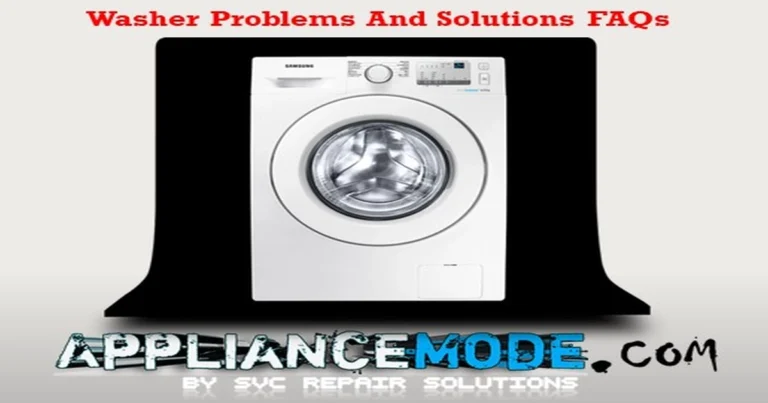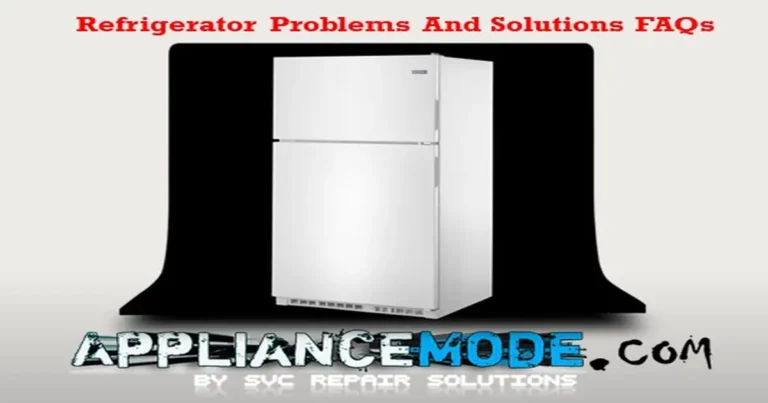On this page
ToggleIf you are a dishwasher owner, you are likely aware of the convenience it provides in terms of having clean dishes without the hassle of handwashing. However, like any other appliance, dishwashers can experience problems that require troubleshooting and repairs.

Regardless of whether you own a Bosch dishwasher, Samsung dishwasher, LG dishwasher, KitchenAid dishwasher, GE dishwasher, or Maytag dishwasher, there are common issues that can arise. This article will address some frequently asked questions about dishwasher problems and solutions. Moreover, although error codes displayed on the control panel can be useful, it is important not to assume that the component indicated is defective. Before considering replacing any parts, make sure to examine all wiring connections.
Dishwasher problems and solutions FAQ: Diagnostic and Troubleshooting Guide Q&A
If you’re noticing that the display isn’t lighting up on your dishwasher, there could be a few reasons for this. It’s possible that your dishwasher isn’t switched on, or the power cord could be unplugged. Another possibility is that the wall outlet you’re using doesn’t have any power or that the internal safety fuses have melted.
To resolve this issue, you can switch on the dishwasher, plug the power cord directly into a wall outlet (avoid using an extension block), check and activate the main power fuse, and measure for 115 Vac (US, CA, MX, etc.) and 220 Vac (EU, UAE, etc.) at the wall outlet. Additionally, you can check the power assembly, internal safety fuse, display board buttons, and harness on the main board.
If you’ve noticed that the display lights up but there’s a power cut-off soon after, there could be a few potential causes. These include an under-dimensioned power group, a faulty power extension block, too much power consumption on the same power group, a shortcut in the dishwasher, or a faulty main board.
To resolve this issue, you can check if the dishwasher is connected to the correct power group (see the specifications in the user manual), avoid using an extension block, check if multiple devices are sharing the same power group, and check the value of the main power fuse. It’s important to note that appliances with high current drains, such as the dishwasher’s heater, may not be able to run at the same time as other appliances. Additionally, you can check the drain pump and the main board to troubleshoot the issue.
If you notice water around your dishwasher, it could be due to a few potential causes. These include leakages at the drain hose, inlet hose(s), or their connections; problems with the doors or gaskets; or leakages inside the dishwasher itself.
To troubleshoot this issue, you can check the standpipe height to ensure it doesn’t exceed the maximum height of 1 meter, look for kinked or restricted drain hose, check for loose connections or cuts in the inlet hose, inspect the door rubber and base of the door for dirt that can create a water tunnel, check the placement of the dishwasher’s filter cover, examine the complete water path for leakages, and ensure that the hoses and gaskets are not damaged. You should also check the tub for damage or improper sealing and adjust the door, top cover, and side panel assemblies as needed.
If you’ve noticed water inside your dishwasher after the program has finished, there could be a few potential causes. These include a kinked or clogged drain hose, a standpipe that’s higher than 1 meter above the floor, a clogged drain filter that causes insufficient pumping action, a faulty drain pump, or a faulty main board.
To troubleshoot this issue, you can check the standpipe height, look for kinked or clogged drain hoses, clean the dishwasher’s pump filter and ensure proper drainage, check the bellows, hoses, filter, and drain pump for any issues, and check the main board for any faults. It’s important to note that some water in the sump is normal, as it’s condensed water from the dry process.
If you notice a sewer smell coming from your dishwasher, it could be caused by leaving dishes in the appliance for too long, clogged drain filters, or a faulty drain pump.
To solve the problem, remove the dishes as soon as the program is finished and leave the door open to ventilate the dishwasher. You should also check for a high water level after opening the door, clean the pump filter, and ensure proper drainage. Use a special dishwasher cleaning product to dissolve remaining detergent residues and kill bacteria that cause the odor.
If you smell a burning odor coming from your dishwasher, it could be caused by an overloaded motor, new electronics, or overheated parts. Check if electronic assemblies have been recently installed, as the smell should disappear after approximately 3–5 days. You should also check for broken dishes or fallen cutlery that may be blocking the circulation motor or the drain pump. Make sure that power connections and assemblies are secure and that connectors are fully inserted.
If your dishwasher will not drain or rinse properly, your dishes may be dirty or not dry well after the end of the program. This can be caused by a kinked or clogged drain hose, a standpipe higher than 1 meter above the floor, clogged drain filters, insufficient pumping action, a faulty drain pump, or a faulty main board.
To solve the problem, check that the standpipe height does not exceed the maximum height of 1m and check for a kinked or restricted drain hose, pipe, or utility sink. Clean the pump filter and ensure proper drain, and check the bellows, hoses, filter, and drain pump. Finally, check the main board for any issues.
If your dishwasher doesn’t start and doesn’t supply water, it could be caused by an enabled child lock or delay, an open door, the dishwasher not filling or washing, the water not draining, or a faulty main board.
To fix this problem, remove the child lock or delay, ensure the door is completely closed, check the water tap and inlet hose, clean the inlet filter, check the water inlet valve, and check the power connections, door lock assembly, bellows, hoses, filter, drain pump, and main board.
If your dishwasher doesn’t fill or fills slowly and won’t start, it could be caused by an opened door, a closed, clogged, not fully opened, or frozen water tap, a kinked inlet hose, a clogged water inlet valve, a blocked air guide, or a faulty main board.
To fix this problem, ensure the door is completely closed, check the water tap and inlet hose, clean the inlet filter, and check the water inlet valve, air guide, and main board.
If your dishes are too wet after the dishwasher finishes, it could be caused by limited or blocked ventilation, loading too many plastic items, insufficient rinse aid, a faulty fan, heater, or main board.
To fix this problem, check the dishwasher’s ventilation and the amount of plastic loaded. Ensure that sufficient rinse aid is added, check the setting for the water hardness, and check the dispenser, fan, air guide, heater, and main board.
If you are experiencing high temperatures when you open your dishwasher after the program has finished, it could be due to a variety of issues. These include stopping or pausing the program before it’s finished, a faulty fan, heater, or main board.
To solve the problem, make sure the dishwasher has completed the program and is in the cooling-down phase. Check the fan, heater, and main board to see if they need to be fixed or replaced.
If you notice tablet residues after the wash cycle is complete, it could be because the ECO program was used or because the wash was done at a low temperature. Additionally, there could be an issue with the heater or main board.
To resolve this, check if the ECO program was used, and if so, use a higher temperature to dissolve the tablets. You can also check the heater and main board to see if they need to be fixed or replaced.
If your dishes are not clean after the program has finished, several factors could be at play. This includes items blocking the spray arms, using the ECO program, washing at low temperatures, heavily soiled dishes, a clogged drain filter, a clogged dispenser, long load times, or a faulty heater or main board.
To fix the issue, check if a low temperature was used and use the INTENSIVE program for heavily soiled or oily dishes. Make sure there is enough clearance for the spray arms and that the dishwasher is loaded correctly. Check and clean the lower and upper spray arms, filter, and dispenser. Verify that the drain connection path is clear and that the heater and main board are working correctly.
The CX detects moisture or steam at the control panel during the program. This can be caused by limited or blocked ventilation, vapor expelling during the cooling-down process, a blocked air guide, a faulty fan, or a faulty main board.
To solve the problem, check if the dishwasher is installed correctly with enough room for ventilation, ensure the dishwasher has completed the program, and check the fan, air guide, and main board.
The CX observes that the dishes have deposits after the program has finished that are not related to food. This can be caused by items blocking the spray arms, calcium or magnesium from hard water, regeneration salt deposits after refill, the incorrect amount of detergent or rinse aid used, washing at low temperature, a clogged drain filter or dispenser, dishes loaded for a long time, a faulty regeneration assembly, or a faulty main board.
To solve the problem, check the correct placement of the filter, clean the spray arms, check the salt level in the softener, and fill the dishwasher with salt and dispenser. Ensure the dishes are placed properly in the dishwasher, check the spray arms for soil remains, and check the regeneration assembly, heater, and main board.
The CX hears an abnormal noise in the dishwasher that is clanging or banging. This can be caused by dishes touching each other, items blocking the spray arms, or loose items in the base.
To solve the problem, check if the dishes are placed properly in the dishwasher, remove loose items that can cause obstruction from the base, and ensure the spray arms can rotate freely and have open vents that spray water.
The CX hears an abnormal noise in the dishwasher that is gurgling, humming, or oscillating. This can be caused by the drain pump pumping air or an older drain pump in an older dishwasher.
To solve the problem, explain that during the drain process, the drain pump will run continuously to remove the water, and during the lifetime of the pump, it will get slightly noisier. Check the drain pump.
The CX hears an intermittent bang in the water lines as a result of pressure differences. This can be caused by recently installed small water lines that are closed, clogged, not fully opened, frozen water taps, or clogged inlet (hose) filters after a longer period of use.
To solve the problem, check the water line diameter for proper dimensions, open the cold-water tap, check the inlet hose, and check the water inlet valve.
The CX observes vibrations, either by touching the dishwasher or by sounds of resonating items. This can be caused by spray arms bumping against or touching the dishes, a not well-level dishwasher, or insufficient space at one of the sides of the dishwasher.
To solve the problem, check the leveling of the dishwasher, ensure the feet are in proper contact with the floor, check the installation of the dishwasher, keep clearance for the sides to prevent transfer of vibrations, check the load of the dishwasher, and check the square correctness of the tub.

I am a master Appliance Repair technician with over 35 years of experience in the field. I am passionate about helping people troubleshoot their appliances and fix common problems. My website, appliancemode.com, provides a wealth of information on troubleshooting common appliance issues and deciphering error codes. This website aims to empower people to tackle appliance repairs themselves and save money on service calls.



